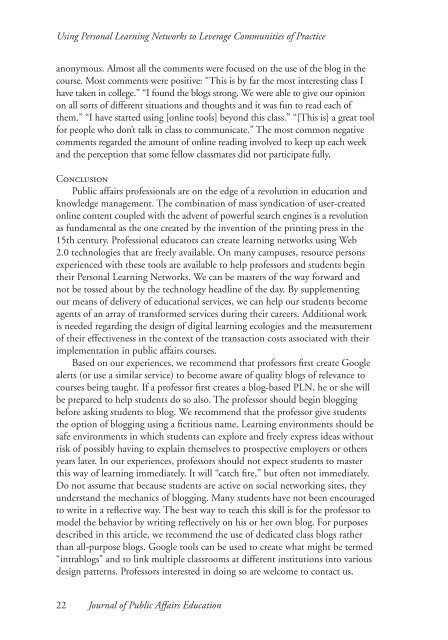Journal of Public Affairs Education
Create successful ePaper yourself
Turn your PDF publications into a flip-book with our unique Google optimized e-Paper software.
Using Personal Learning Networks to Leverage Communities <strong>of</strong> Practice<br />
anonymous. Almost all the comments were focused on the use <strong>of</strong> the blog in the<br />
course. Most comments were positive: “This is by far the most interesting class I<br />
have taken in college.” “I found the blogs strong. We were able to give our opinion<br />
on all sorts <strong>of</strong> different situations and thoughts and it was fun to read each <strong>of</strong><br />
them.” “I have started using [online tools] beyond this class.” “[This is] a great tool<br />
for people who don’t talk in class to communicate.” The most common negative<br />
comments regarded the amount <strong>of</strong> online reading involved to keep up each week<br />
and the perception that some fellow classmates did not participate fully.<br />
Conclusion<br />
<strong>Public</strong> affairs pr<strong>of</strong>essionals are on the edge <strong>of</strong> a revolution in education and<br />
knowledge management. The combination <strong>of</strong> mass syndication <strong>of</strong> user-created<br />
online content coupled with the advent <strong>of</strong> powerful search engines is a revolution<br />
as fundamental as the one created by the invention <strong>of</strong> the printing press in the<br />
15th century. Pr<strong>of</strong>essional educators can create learning networks using Web<br />
2.0 technologies that are freely available. On many campuses, resource persons<br />
experienced with these tools are available to help pr<strong>of</strong>essors and students begin<br />
their Personal Learning Networks. We can be masters <strong>of</strong> the way forward and<br />
not be tossed about by the technology headline <strong>of</strong> the day. By supplementing<br />
our means <strong>of</strong> delivery <strong>of</strong> educational services, we can help our students become<br />
agents <strong>of</strong> an array <strong>of</strong> transformed services during their careers. Additional work<br />
is needed regarding the design <strong>of</strong> digital learning ecologies and the measurement<br />
<strong>of</strong> their effectiveness in the context <strong>of</strong> the transaction costs associated with their<br />
implementation in public affairs courses.<br />
Based on our experiences, we recommend that pr<strong>of</strong>essors first create Google<br />
alerts (or use a similar service) to become aware <strong>of</strong> quality blogs <strong>of</strong> relevance to<br />
courses being taught. If a pr<strong>of</strong>essor first creates a blog-based PLN, he or she will<br />
be prepared to help students do so also. The pr<strong>of</strong>essor should begin blogging<br />
before asking students to blog. We recommend that the pr<strong>of</strong>essor give students<br />
the option <strong>of</strong> blogging using a fictitious name. Learning environments should be<br />
safe environments in which students can explore and freely express ideas without<br />
risk <strong>of</strong> possibly having to explain themselves to prospective employers or others<br />
years later. In our experiences, pr<strong>of</strong>essors should not expect students to master<br />
this way <strong>of</strong> learning immediately. It will “catch fire,” but <strong>of</strong>ten not immediately.<br />
Do not assume that because students are active on social networking sites, they<br />
understand the mechanics <strong>of</strong> blogging. Many students have not been encouraged<br />
to write in a reflective way. The best way to teach this skill is for the pr<strong>of</strong>essor to<br />
model the behavior by writing reflectively on his or her own blog. For purposes<br />
described in this article, we recommend the use <strong>of</strong> dedicated class blogs rather<br />
than all-purpose blogs. Google tools can be used to create what might be termed<br />
“intrablogs” and to link multiple classrooms at different institutions into various<br />
design patterns. Pr<strong>of</strong>essors interested in doing so are welcome to contact us.<br />
22 <strong>Journal</strong> <strong>of</strong> <strong>Public</strong> <strong>Affairs</strong> <strong>Education</strong>



